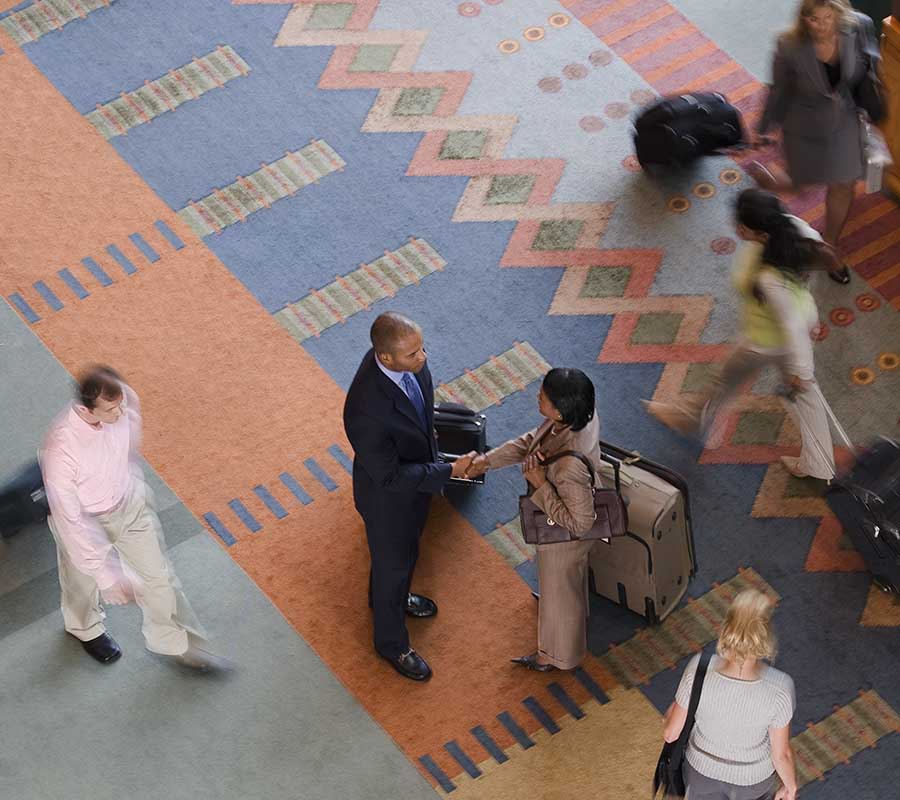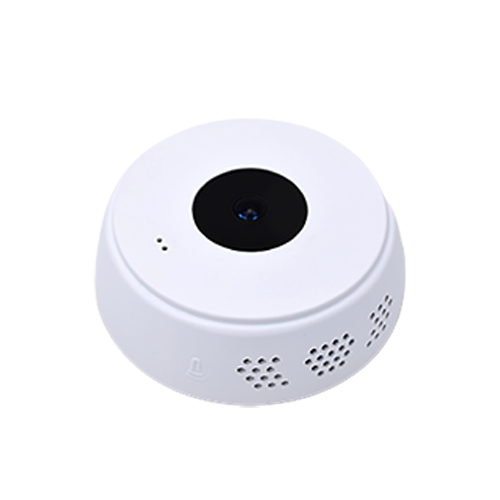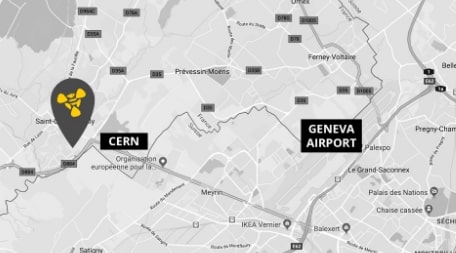Occupancy monitoring 101: what it is & why it’s essential
In this article, we take a look at what occupancy monitoring is, the different types of occupancy monitoring sensors on the market, and how this technology is proving indispensable to businesses and Smart Buildings.
What is occupancy monitoring?
Occupancy monitoring – also known as people counting – is the process of measuring the number of people occupy a given space at a given time.
In the most basic sense, occupancy monitoring can be carried out by manually counting the number of people who enter and exit a room or building – however, modern occupancy monitoring systems seek to achieve this using networked occupancy monitoring sensors.
Typically, occupancy monitoring systems work by counting people as they enter and leave a designated space. Positioning occupancy monitoring sensors in entrances and exits allows them to monitor the flow of people traffic in and out of a room and record a running total of room occupancy. In this way, occupancy monitoring systems provide a robust, low-cost solution while enabling in-depth analysis and automation using occupancy data.
Benefits of occupancy monitoring

Whether occupancy monitoring sensors are deployed in reception areas, shop floors, meeting rooms, or throughout an entire office complex; occupancy monitoring systems provide valuable insight into exactly how spaces are used.
This insight enables better decision-making for the allocation of space, staff and resources; helping businesses run more efficiently and safely.
Occupancy monitoring systems provide access both to real-time and historical data. While real-time occupancy monitoring data provides instant information on current usage, historical data reveals trends in occupancy over days, weeks, months and years.
Occupancy monitoring systems are a rich source of information that can be put to immediate practical use in a number of ways.
Understanding how much space is required
One of the most valuable applications of occupancy monitoring is in optimizing commercial real-estate expenditure.
With the last few years bringing about a shift in the way businesses use space, traditional ideas around the roles of workplaces are now being called into question (1). Many employees now spread their working hours between home and office – but the costs of maintaining physical premises remain as high as ever. The result is that many businesses are reevaluating how much space they really need.
Is your business paying for more space than it truly needs? Installing an occupancy monitoring system provides a low-cost way of definitively answering this question. Simply by positioning occupancy monitoring sensors above doorways, businesses can rapidly assess whether spaces are being efficiently used and take steps to manage space more effectively.
Occupancy monitoring systems can identify underutilized and overcrowded areas, inform better decisions regarding space allocation, and provide the accurate data businesses decision-makers need when considering downsizing their premises.
Occupancy monitoring for resource allocation
Occupancy monitoring can provide insights that enable you to reduce energy expenditure and carbon emissions. Smart Buildings use networked occupancy monitoring sensors to automate power-hungry lighting, heating and air-conditioning systems.
In modern workplaces, heating, lighting, air conditioning and security systems often work around the clock, using a huge amount of energy.
In the US, for example, HVAC systems consume 35% of the total energy used by a building, with lighting accounting for a further 11% (2). Commercial buildings in the US account for around 36% of all electricity use. (3)
This energy use is often considered to be an unavoidable expense. However, much of this energy is wasted: every day, countless businesses pay to heat, cool and illuminate unoccupied rooms.
Smart Buildings systems aim to reduce wasted energy through automatic management of HVAC, lighting and other power-intensive subsystems.
Occupancy counting systems play a key role in these applications: networkable occupancy monitoring sensors can provide real-time room occupancy monitoring, enabling energy and resources to be directed to where and when they are needed most.
By automatically switching off lighting in unoccupied areas, directing ventilation to crowded rooms, and optimizing heating to suit working schedules, occupancy monitoring systems can enable businesses to significantly reduce expenditure and energy use.
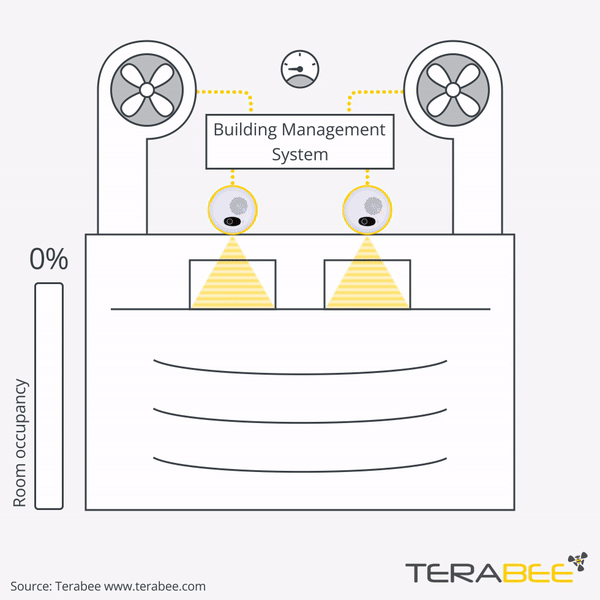
Occupancy monitoring driving comfort of tenants and workers
Real-time information on people density helps businesses prevent overcrowding, increasing safety and comfort.
During the pandemic, the responsibility of ensuring safety in commercial spaces fell on the shoulders of business owners (4). Many opted for manual people counting as a means of adhering to social distancing guidelines – though this type of occupancy monitoring proved prohibitively labor-intensive in many cases.
Changing regulations and fluctuating transmission rates have shown the importance of implementing occupancy counting measures that can ensure safe working conditions and provide resilience in the future.
Occupancy monitoring systems provide a simple and low-cost solution to this challenge. People counting data can be easily used to calculate people density within a room or building. This enables businesses to keep on top of overcrowding and ensure that workplaces remain safe for employees and visitors alike.
5 types of sensors for occupancy monitoring
A number of different occupancy monitoring technologies are available on the market, each with different strengths and weaknesses.

Cameras
Digital cameras are a mature technology, and modern image processing algorithms are capable of very accurate occupancy monitoring. However, camera hardware is expensive, and configuring their image processing to work in all occupancy monitoring conditions can be complex. In addition, GDPR and privacy concerns regarding the use of cameras make them unappealing to many businesses. (5)
RFID
Radiofrequency identification (RFID) occupancy monitoring systems work by detecting and counting tags that are distributed to personnel. Inexpensive and simple to configure, RFID occupancy monitoring systems do not require line-of-sight for occupancy monitoring. However, the requirement to issue RFID tags typically limits this technology to “closed systems” such as warehouses and laboratories. In addition, RFID occupancy monitoring systems aren’t anonymous, giving rise to the same data-handling and GDPR issues as cameras.
WiFi/Bluetooth beacon
These occupancy monitoring systems operate on a similar basis to RFID – but, rather than issuing tags to personnel, the system detects peoples’ smartphones or other applicable devices using Bluetooth and WiFi. While this broadens occupancy monitoring use cases to “open systems” such as shop floors, WiFi/beacon occupancy monitoring systems suffer from poor accuracy because of the intrinsic assumption that each person carries exactly one WiFi or Bluetooth enabled device. In addition, they’re not suitable for anonymous occupancy monitoring.
Thermal sensors
Thermal sensors are essentially cameras that detect infrared rather than visible light. However, they offer a big advantage in occupancy monitoring applications: they can carry out people counting by detecting the thermal profile of people without recording any identifying information. This comes at a cost: thermal occupancy monitoring sensors are generally expensive and difficult to configure.
Infrared Time-of-Flight sensors
This type of occupancy monitoring sensor works by emitting a pulse of infrared light and measuring the “echo” as the pulse reflects off the environment and back to the sensor. In this way, Time-of-Flight occupancy monitoring systems can take 3D snapshots of their surroundings, which can be processed to obtain occupancy monitoring data. Low spatial resolution keeps hardware costs low and makes time-of-flight sensors intrinsically anonymous.
Understanding workplace occupancy with Terabee
Terabee occupancy monitoring systems use infrared Time-of-Flight technology to deliver completely anonymous occupancy monitoring with typically accuracy of 98%, or more.
Using powerful onboard algorithms, Terabee people counting devices filter out static objects and deliver accurate occupancy monitoring even in crowded bi-directional traffic and low-light conditions.
Terabee people counting sensors can be easily installed above any doorway and configured in seconds from any web-enabled device. A simple IoT platform enables seamless integration of occupancy monitoring data for data analytics or smart building applications.
Terabee produces two versatile occupancy monitoring systems to help businesses understand their workplace occupancy. The first is People Counting L-XL, offering a wide Field of View and multi-device connectivity for extra wide doorways and passageways. The People Counting M, Terabee’s second offering, is a low-cost occupancy monitoring solution optimized for narrow walkways and single doors.
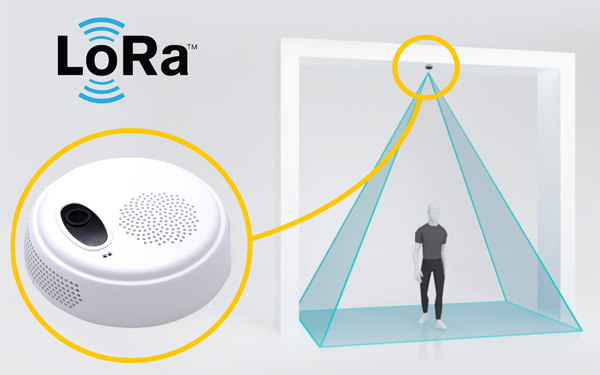
Talk to our experienced team about your people counting needs, by simply outlining your application and any specific needs.
References and further reading
- How Coronavirus Has Changed the Way Americans Work. Pew Research Center’s Social & Demographic Trends Project https://www.pewresearch.org/social-trends/2020/12/09/how-the-coronavirus-outbreak-has-and-hasnt-changed-the-way-americans-work/ (2020)
- Chapter 5: Increasing Efficiency of Building Systems and Technologies. 39.
- King, J. Smart Buildings: Using Smart Technology to Save Energy in Existing Buildings. SMART BUILDINGS 55
- CDC. Coronavirus Disease 2019 (COVID-19) – Interim Guidance for Businesses and Employers. Centers for Disease Control and Prevention https://www.cdc.gov/coronavirus/2019-ncov/community/guidance-business-response.html (2020)
- Ahmad, J., Larijani, H., Emmanuel, R., Mannion, M. & Javed, A. Occupancy detection in non-residential buildings – A survey and novel privacy preserved occupancy monitoring solution. Applied Computing and Informatics (2018) doi:10.1016/j.aci.2018.12.001


